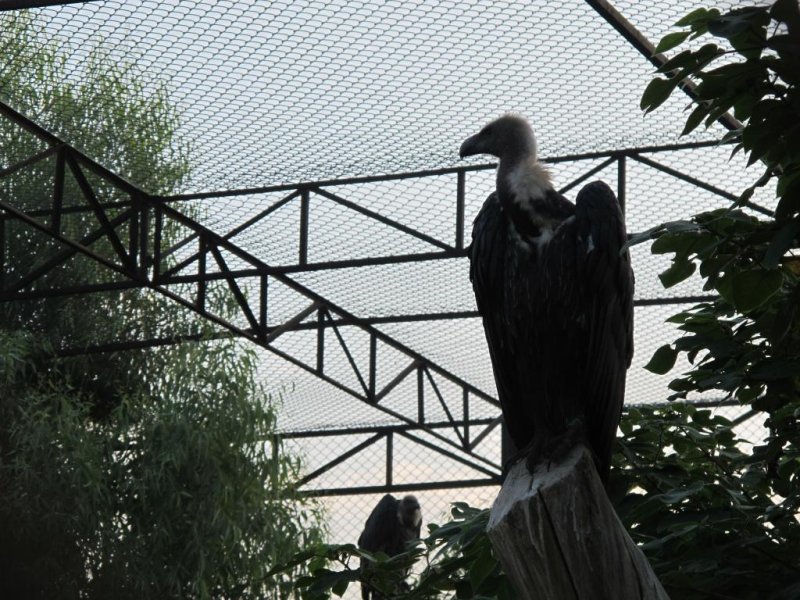1 of 4 | Endangered Oriental white-backed vultures, also known as white-humped vultures, keep a watchful eye on human onlookers from their perches in trees near Kasur in Pakistan's Changa Manga Forest. The vulture population restoration project is run by the World Wide Fund for Nature-Pakistan in partnership with the Punjab Wildlife and Parks Department, the Environment Agency, Abu Dhabi and the Hawk Conservancy Trust (United Kingdom). Photo courtesy WWF-Pakistan/Syed Muhammad Abubakar
KASUR, Pakistan, Feb. 2 (UPI) -- With several species of vultures on the verge of extinction in Pakistan, largely because of veterinary drugs used on cattle, an environmental group is investing in a captive breeding program it hopes will contribute to the recovery of the iconic birds.
Deep in the Changa Manga forest, 45 miles from Lahore, World Wide Fund for Nature-Pakistan is working with the Punjab Wildlife Department to restore the population of the Oriental white-backed vulture, also known as the white-rumped vulture. The scavengers have long been a crucial part of the ecosystem in Pakistan and across South Asia, helping to prevent disease and contamination of groundwater by feeding on animal carcasses.
"We are fighting a losing battle but we can minimize the impact," Hasan Ali, a WWF-Pakistan conservation coordinator, said, speaking through a translator.
On a recent visit to the program, there was a festive feel in the air as workers serenaded the caged vultures before feeding the bald black-and-white birds with the trademark curved beaks chunks of donkey and goat meat. The goal of the program is to help build up the numbers of birds, which have wingspans up to 8 feet, until the environment is safe to release them.
Populations of the white-backed vulture (Gyps bengalensis) and the long-billed vulture (Gyps indicus) have dropped by more than 90 percent and are considered critically endangered across South Asia, mostly because of the use of veterinary drugs such as diclofenac, a non-steroidal anti-inflammatory drug, that have contaminated the cattle carcasses the birds feed on, the International Union for Conservation of Nature says. The drugs cause the vultures to suffer renal failure and death.
Uzma Saeed, another WWF-Pakistan conservation coordinator, concedes there is still much work left to bring these birds back from the brink of extinction.
Part of the problem, Saeed said, is that the veterinary drugs are still being used despite a long-running ban in place across South Asia aimed at helping the vultures recover. A new class of pain killers for livestock has been introduced, including ketoprofen and aceclofenac, which pose similar threats to the vultures.
Muhammad Shafqat, director of the Punjab Wildlife Department, said authorities have levied fines and shut down pharmaceutical companies caught producing diclofenac, and are attempting to raise awareness about the importance of the birds.
"We have specified five zones for vultures breeding in Punjab besides launching awareness programs," he said.
However, it is not drugs alone that cause the vulture numbers to plummet. Another important factor may be the reduction of carcasses because of improved veterinary and livestock husbandry services and better carcass disposal in urban and semi-urban areas. The presence of two Gyps species in the remote Nagar Parkar area seems to support that argument, as veterinary and livestock husbandry services there are less sophisticated.
The birds' breeding sites are also threatened by the loss of Dalbergia Sissoo trees, often home to vulture nests. An increasing number have been cut down by villagers for firewood, while others have fallen victim to termite attacks and dieback disease.
Muhammad Akram, dean of Wildlife and Fisheries at the University of Animal Sciences in Lahore, also blamed the lack of awareness among general public, unplanned urbanization, deforestation, lack of government attention and aggressive human behavior as factors behind the vultures' decline.
"Even scientists with doctorates in Pakistan do not know what functions vultures perform for the environment," Akram said through a translator.
Ijaz Khan, a farmer from Burki village, is typical of most Pakistanis. Rather than recognizing the important role played by the birds, Khan said he was glad to see them disappear.
"Stray dogs are enough in the city to eat the dead animals. I am happy vultures have disappeared from our beautiful land," Khan said.
None of this has dampened the desire of Saeed and other environmentalists to save the vulture. Along with the captive breeding program, WWF-Pakistan is also trying to educate the public about the birds and pressuring the government to do more to enforce the ban on the harmful veterinary drugs.
"We will do what we can to save vultures from the cruel clutches of human beings," Saeed said. "We will leave no stone unturned for this purpose come what may."





